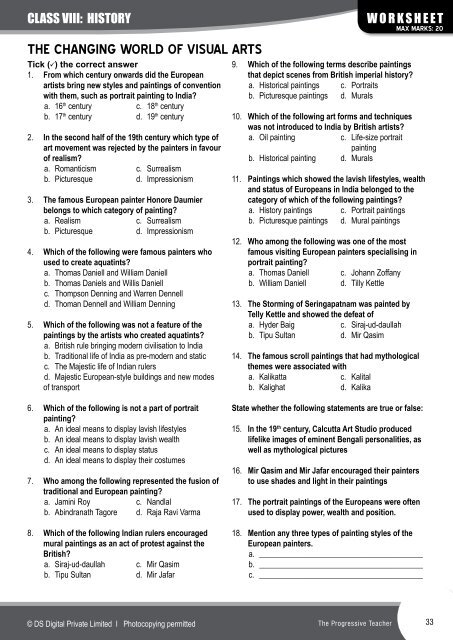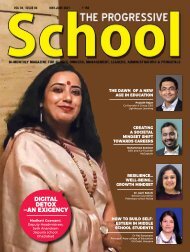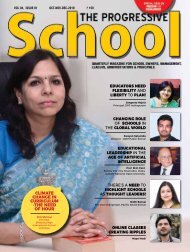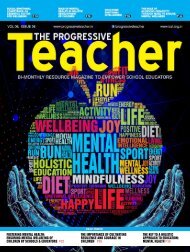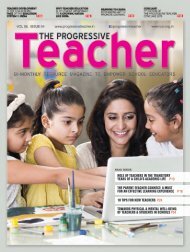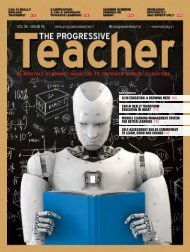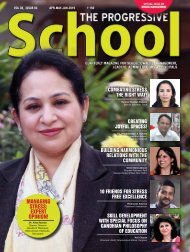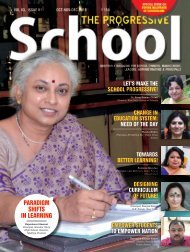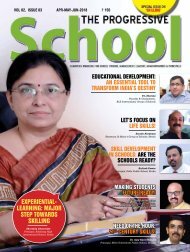The Progressive Teacher Vol 04 Issue 03
This issue of The Progressive Teacher focuses on "New Trends in Education ". In this edition, articles explore contemporary trends to enhance interactive learning amongst students.
This issue of The Progressive Teacher focuses on "New Trends in Education ". In this edition, articles explore contemporary trends to enhance interactive learning amongst students.
Create successful ePaper yourself
Turn your PDF publications into a flip-book with our unique Google optimized e-Paper software.
Class VIII: history<br />
<strong>The</strong> Changing World of Visual Arts<br />
Tick ( ) the correct answer<br />
1. From which century onwards did the European<br />
artists bring new styles and paintings of convention<br />
with them, such as portrait painting to India?<br />
a. 16 th century c. 18 th century<br />
b. 17 th century d. 19 th century<br />
2. In the second half of the 19th century which type of<br />
art movement was rejected by the painters in favour<br />
of realism?<br />
a. Romanticism c. Surrealism<br />
b. Picturesque d. Impressionism<br />
3. <strong>The</strong> famous European painter Honore Daumier<br />
belongs to which category of painting?<br />
a. Realism c. Surrealism<br />
b. Picturesque d. Impressionism<br />
4. Which of the following were famous painters who<br />
used to create aquatints?<br />
a. Thomas Daniell and William Daniell<br />
b. Thomas Daniels and Willis Daniell<br />
c. Thompson Denning and Warren Dennell<br />
d. Thoman Dennell and William Denning<br />
5. Which of the following was not a feature of the<br />
paintings by the artists who created aquatints?<br />
a. British rule bringing modern civilisation to India<br />
b. Traditional life of India as pre-modern and static<br />
c. <strong>The</strong> Majestic life of Indian rulers<br />
d. Majestic European-style buildings and new modes<br />
of transport<br />
worksheet<br />
Max Marks: 20<br />
9. Which of the following terms describe paintings<br />
that depict scenes from British imperial history?<br />
a. Historical paintings c. Portraits<br />
b. Picturesque paintings d. Murals<br />
10. Which of the following art forms and techniques<br />
was not introduced to India by British artists?<br />
a. Oil painting c. Life-size portrait<br />
painting<br />
b. Historical painting d. Murals<br />
11. Paintings which showed the lavish lifestyles, wealth<br />
and status of Europeans in India belonged to the<br />
category of which of the following paintings?<br />
a. History paintings c. Portrait paintings<br />
b. Picturesque paintings d. Mural paintings<br />
12. Who among the following was one of the most<br />
famous visiting European painters specialising in<br />
portrait painting?<br />
a. Thomas Daniell c. Johann Zoffany<br />
b. William Daniell d. Tilly Kettle<br />
13. <strong>The</strong> Storming of Seringapatnam was painted by<br />
Telly Kettle and showed the defeat of<br />
a. Hyder Baig c. Siraj-ud-daullah<br />
b. Tipu Sultan d. Mir Qasim<br />
14. <strong>The</strong> famous scroll paintings that had mythological<br />
themes were associated with<br />
a. Kalikatta c. Kalital<br />
b. Kalighat d. Kalika<br />
6. Which of the following is not a part of portrait<br />
painting?<br />
a. An ideal means to display lavish lifestyles<br />
b. An ideal means to display lavish wealth<br />
c. An ideal means to display status<br />
d. An ideal means to display their costumes<br />
7. Who among the following represented the fusion of<br />
traditional and European painting?<br />
a. Jamini Roy c. Nandlal<br />
b. Abindranath Tagore d. Raja Ravi Varma<br />
8. Which of the following Indian rulers encouraged<br />
mural paintings as an act of protest against the<br />
British?<br />
a. Siraj-ud-daullah c. Mir Qasim<br />
b. Tipu Sultan d. Mir Jafar<br />
State whether the following statements are true or false:<br />
15. In the 19 th century, Calcutta Art Studio produced<br />
lifelike images of eminent Bengali personalities, as<br />
well as mythological pictures<br />
16. Mir Qasim and Mir Jafar encouraged their painters<br />
to use shades and light in their paintings<br />
17. <strong>The</strong> portrait paintings of the Europeans were often<br />
used to display power, wealth and position.<br />
18. Mention any three types of painting styles of the<br />
European painters.<br />
a. _________________________________________<br />
b. _________________________________________<br />
c. _________________________________________<br />
© DS Digital Private Limited I Photocopying permitted <strong>The</strong> <strong>Progressive</strong> <strong>Teacher</strong><br />
33


